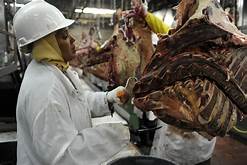What I learned on the line at a Dodge City slaughterhouse.
MEAT HOUSE: AMERICA’S MOST DANGEROUS INDUSTRIES:
On the morning of may 25, 2019, a food-safety inspector at a Cargill meatpacking plant in Dodge City, Kansas, came across a disturbing sight. In an area of the plant called the stack, a Hereford steer had, after being shot in the forehead with a bolt gun, regained consciousness. Or maybe he had never lost it. Either way, this wasn’t supposed to happen. The steer was hanging upside down by a steel chain shackled to one of his rear legs. He was showing what is known in the euphemistic language of the American beef industry as “signs of sensibility.” His breathing was “rhythmic.” His eyes were open and moving. And he was trying to right himself, which the animals commonly do by arching their back. The only sign he wasn’t exhibiting was “vocalization.”
The inspector, who worked for the U.S. Department of Agriculture, told employees in the stack to stop the moving overhead chain to which the cattle were attached and “reknock” the steer. But when one of them pulled the trigger on a handheld bolt gun, it misfired. Someone brought over another gun to finish the job. “The animal was then stunned adequately,” the inspector wrote in a memorandum describing the incident, noting that “the timeframe from observing the apparent egregious action to the final euthanizing stun was approximately 2 to 3 minutes.”
Three days after the incident occurred, the USDA’s Food Safety and Inspection Service, citing the plant’s history of compliance, put the plant on notice for its “failure to prevent inhumane handling and slaughter of livestock.” FSIS ordered the plant to create an action plan to ensure that such an incident didn’t happen again. On June 4, the agency approved a plan submitted by the plant’s manager and said in a letter to him that it would defer a decision about punishment. The chain could keep moving, and with it the slaughtering of up to 5,800 cows a day.
The first time I stepped foot in the stack was late last October, after I had been working at the plant for more than four months. To find it, I arrived early one day and worked my way backwards down the chain. It was surreal to see the slaughter process in reverse, to witness step-by-step what it would take to reassemble a cow: shove its organs back into its body cavities; reattach its head to its neck; pull its hide back over its flesh; draw blood back into its veins.
During my visits to the kill floor, I saw a severed hoof lying inside a metal sink in the skinning room, and puddles of bright-red blood dotting the red-brick floor. One time, a woman in a yellow synthetic-rubber apron was trimming away flesh from skinless, decapitated heads. A USDA inspector working next to her was doing something similar. I asked him what he was cutting. “Lymph nodes,” he said. I found out later that he was performing a routine check for diseases and contamination.
On my last trip to the stack, I tried to be inconspicuous. I stood against the back wall and watched as two men standing on a raised platform cut vertical incisions down the throat of each passing cow. As far as I could tell, all of the animals were unconscious, though a few of them involuntarily kicked their legs. I watched until a supervisor came over and asked what I was doing. I told him I wanted to see what this part of the plant was like. “You need to leave,” he said. “You can’t be here without a face shield.” I apologized and told him that I would get going. I couldn’t have stayed for much longer anyway; my shift was about to start.
Getting a job at the Cargill plant was surprisingly easy. The online application for “general production” was six pages long. It took less than 15 minutes to fill out. At no point was I required to submit a résumé, let alone references. The most substantial part of the application was a 14-question form that asked things like:
“Do you have experience working with knives to cut meat (this does not include working in a grocery store or deli)?”
No.
“How many years have you worked in a beef production plant (example: slaughter or fabrication, not a grocery store or deli)?”
No experience.
“How many years have you worked in a production or plant environment (example: assembly line or manufacturing work)?”
Zero.
“And what did you do there?” the woman asked about my time at the Church.
“Communications,” I said.
The woman asked a couple of follow-up questions about when I quit and why. During the interview, the only question that gave me pause was the final one.
“Do you have any issues or concerns working in our environment?” she asked.
After hesitating for a moment, I replied, “No, I don’t.”
With that, the woman said that I was “eligible for a verbal, conditional job offer.” She told me about the six positions for which the plant was hiring. All were for the second shift, which at the time was running from 3:45 in the afternoon to between 12:30 and 1 o’clock in the morning. Three of the jobs were in harvesting, the side of the plant more commonly known as the kill floor, and three were in fabrication, where the meat is prepared for distribution to stores and restaurants.
I quickly decided that I wanted a job in fab. Temperatures on the kill floor can approach 100 degrees in the summer, and, as the woman on the phone explained, “the smell is stronger because of the humidity.” Then there were the jobs themselves, jobs like removing hides and “dropping tongues.” After you remove the tongue, the woman said, “you do have to hang it on a hook.” Her description of fab, on the other hand, made it sound less medieval and more like an industrial-scale butcher shop. A small army of assembly-line workers saw, cut, trim, and package all of the meat from the cows. The temperature on the fab floor ranges from 32 to 36 degrees. But, the woman told me, you work so hard that “you don’t feel the cold once you’re in there.”
On the evening before I left for Dodge City, my mom and I went to my sister and brother-in-law’s house for a steak dinner. “It might be the last one you ever have,” my sister said.
We went over the job openings. Chuck cap puller was immediately out because it involved walking and cutting at the same time. The next to go was brisket bone for the simple reason that having to remove something called brisket fingers from in between joints sounded unappealing. That left chuck final trim. That job, as the woman described it, consisted entirely of trimming pieces of chuck “to whatever spec it is that they’re running.” How hard could that be? I thought to myself. I told the woman that I would take it. “Perfect,” she said, and went on to tell me my starting pay ($16.20 an hour) and the conditions of my job offer.
A couple of weeks later, after a background check, a drug screening, and a physical exam, I got a call about my start date: June 8, the following Monday. The drive to Dodge City from Topeka, where I had been living with my mom since mid-March because of the coronavirus pandemic, takes about four hours. I decided that I would leave on Sunday.
On the evening before I left, my mom and I went to my sister and brother-in-law’s house for a steak dinner. “It might be the last one you ever have,” my sister said when she called to invite us over. My brother-in-law grilled two 22-ounce rib eyes for him and me and a 24-ounce sirloin for my mom and sister to split. I helped my sister cook the side dishes: mashed potatoes and green beans sautéed in butter and bacon grease. The quintessential home-cooked meal for a middle-class family in Kansas.
The steak was as good as any I’ve had. It’s hard to describe it without sounding like an Applebee’s commercial: charred crust, juicy and tender meat. I tried to eat slowly so that I could savor every bite. But soon I was caught up in conversation, and I finished eating without thinking about it. In a state where cows outnumber people two to one, where more than 5 billion pounds of beef are produced annually, and where many families—including mine, when my three sisters and I were younger—fill their deep freezer once a year with a side of beef, it’s easy to take a steak dinner for granted.
The cargill plant is on the southeastern outskirts of Dodge City, just down the road from a slightly larger meatpacking plant owned by National Beef. The two facilities sit at opposite ends of what is surely the most noxious two-mile stretch of road in southwestern Kansas. Situated close by is a wastewater-treatment plant and a feedlot. On many days last summer, I found the stench of lactic acid, hydrogen sulfide, manure, and death to be nauseating. The oppressive heat only made it worse.
The High Plains of southwestern Kansas are home to four major meatpacking plants: the two in Dodge City, plus one in Liberal (National Beef) and another near Garden City (Tyson Foods). That Dodge City became home to two meatpacking plants is a fitting coda to the town’s early history. Founded in 1872 along the Atchison, Topeka, and Santa Fe Railroad, Dodge City was originally an outpost for buffalo hunters. After the herds that once roamed the Great Plains were decimated—to say nothing of what happened to the Native Americans who’d once lived there—the city turned to the cattle trade.
Practically overnight, Dodge City became, in the words of a prominent local businessman, “the greatest cattle market in the world.” This was the era of lawmen like Wyatt Earp and gunfighters like Doc Holliday, of gambling and shoot-outs and barroom brawls. To say that Dodge City is proud of its Wild West heritage would be an understatement, and nowhere is that heritage more celebrated—some might say mythologized—than at the Boot Hill Museum. Located at 500 West Wyatt Earp Boulevard, near Gunsmoke Street and the Gunfighters Wax Museum, the Boot Hill Museum is anchored by a full-scale replica of the once-famous Front Street. Visitors can enjoy a sarsaparilla at the Long Branch Saloon or shop for handmade soap and homemade fudge at the Rath & Co. General Store. Entry to the museum is free for Ford County residents, a deal that I took advantage of many times last summer after I moved into a one-bedroom apartment near the local VFW.
Yet for all its dime-novel-worthy stories, Dodge City’s Wild West era was short-lived. In 1885, under growing pressure from local ranchers, the Kansas legislature banned Texas cattle from the state, bringing an abrupt end to the cattle drives that had fueled the town’s boom years. For the next seven decades, Dodge City remained a quiet farming community. Then, in 1961, a company called Hyplains Dressed Beef opened the first meatpacking plant in town (the same one now operated by National Beef). In 1980, a subsidiary of Cargill opened its plant down the road. The beef industry had returned to Dodge City.
This article was published online on June 14, 2021. –










